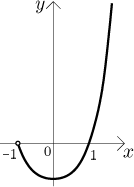Problem: Identify the shape of the parametric curve
Solution: There is no point in using some theorem, because it would only (with a bit of luck) guarantee a local existence, while we want a global and concrete description. We could also try the standard procedure for drawing parametric curves (see Parametric functions in Derivative - Theory - Graphing, or Parametric functions in Derivative - Methods Survey - Graphing), but that would only give us a sketch, while the question says "identify". The only procedure that would actually precisely identify the shape is changing the parametric description either into a function, or at least to some implicit equation that we recognize.
This is done by eliminating t from the description. Can we express t from one of the two equations above? The first equation looks quite inviting, so we can try it. We notice that we do not really need t itself, since we will want to substitute for t into the formula for y, but there this t is always as et, so it is enough to express this exponential from the first equation.
![]()
The equation
The expression
How about the other coordinate? The expression
The conclusion is that the given parametric equations describe a piece of the
parabola
